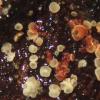
08-01-2026 21:22
 Blasco Rafael
Blasco Rafael
Hola, He recogido esta muestra de Orbilia sobre Re

07-01-2026 10:24
 Danny Newman
Danny Newman
Pezicula sp. on indet. hardwood Appalachian Highl

07-01-2026 22:22
 Danny Newman
Danny Newman
Tatraea sp. on indet. hardwood The Swag, Great Sm

07-01-2026 17:29
 Marc Detollenaere
Marc Detollenaere
Dear Forum,On a barkless Populus I found some smal

10-11-2021 17:33
 Riet van Oosten
Riet van Oosten
Add-on topic http://www.ascofrance.com/forum/7059

07-01-2026 10:05
 Danny Newman
Danny Newman
cf. Chaetospermum on XylariaCosby Campground, Grea

02-01-2026 17:43
MARICEL PATINOHi there, although I couldn't see the fruitbody, I

04-01-2026 17:45
 Stephen Martin Mifsud
Stephen Martin Mifsud
I was happy to find these orange asmocyetes which
Calycina conorum
Yannick Mourgues,
01-02-2008 23:49
 Bonsoir.
Bonsoir.J'ai observé que Calycina conorum rougissait fortement à la blessure. Est-ce que l'un d'entre vous saurait pourquoi ? Quelle est la réaction chimique responsable de cela ?
I have watched that Calycina conorum becomes strongly reddening when hurted. Do you know why ? What is the chemical process ?
Merci par avance.
Yannick
Perz Piotr,
02-02-2008 09:39
Re:Calycina conorum
Hi Yannick
I thint this is oxidation of VBs i paraphyses, marginal- & excipulum cells.
Pimpek
I thint this is oxidation of VBs i paraphyses, marginal- & excipulum cells.
Pimpek
Hans-Otto Baral,
02-02-2008 11:38

Re:Calycina conorum
Yes, it is a wide-spread property in Helotiales and always the result of oxidation of refractive vacuoles. Typical of Lachnum, Bryoscyphus, some of Calycina etc. I think it has to do with benzol rings in which the double bindings change through oxidation and therefore get coloured. It is always a lethal process so that redbrown paraphysis or hair cells are never coloured as long as they are alive.
We have so important vital characters like VBs and we know so little about thier chemical background. It would be an interesting field of research for chemistry.
Zotto
We have so important vital characters like VBs and we know so little about thier chemical background. It would be an interesting field of research for chemistry.
Zotto


